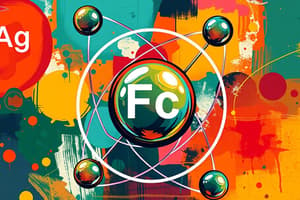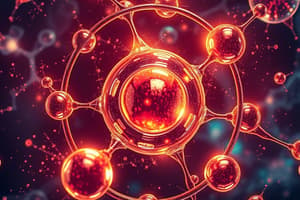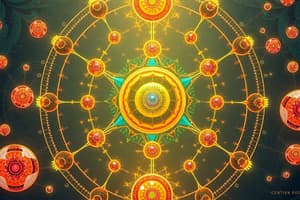Podcast
Questions and Answers
Which of the following statements is true regarding proteins?
Which of the following statements is true regarding proteins?
- All proteins are globular.
- Hydrogen bonds are weak bonds that can affect a protein's shape. (correct)
- Lipoproteins are only formed from fibrous proteins.
- Collagen is an example of a globular protein.
RNA contains thymine as one of its nitrogen bases.
RNA contains thymine as one of its nitrogen bases.
False (B)
What is the primary energy source for cellular activities?
What is the primary energy source for cellular activities?
ATP (adenosine triphosphate)
Nucleotides are made up of a pentose sugar, a phosphate group, and a _________ base.
Nucleotides are made up of a pentose sugar, a phosphate group, and a _________ base.
Match the following nucleic acids with their characteristics:
Match the following nucleic acids with their characteristics:
What substance dissociates to give H+ ions?
What substance dissociates to give H+ ions?
A base dissociates to give OH- ions.
A base dissociates to give OH- ions.
What is the pH of a neutral solution?
What is the pH of a neutral solution?
A salt dissociates into _____ and _____ ions.
A salt dissociates into _____ and _____ ions.
Which of the following correctly defines a polymer?
Which of the following correctly defines a polymer?
Match the type of compound with its correct description:
Match the type of compound with its correct description:
Hydrocarbons are made of carbon and nitrogen only.
Hydrocarbons are made of carbon and nitrogen only.
Organic compounds are characterized by the presence of _____ and _____.
Organic compounds are characterized by the presence of _____ and _____.
What is the smallest unit of an element of matter?
What is the smallest unit of an element of matter?
A compound is a combination of two or more atoms of the same element.
A compound is a combination of two or more atoms of the same element.
What defines the atomic number of an element?
What defines the atomic number of an element?
The number of neutrons can be found by subtracting the atomic number from the _____.
The number of neutrons can be found by subtracting the atomic number from the _____.
Match the following terms with their definitions:
Match the following terms with their definitions:
Electrons are positively charged particles that reside in an atom's nucleus.
Electrons are positively charged particles that reside in an atom's nucleus.
What is a radioisotope?
What is a radioisotope?
What type of reaction occurs when two or more smaller molecules combine to form a larger molecule?
What type of reaction occurs when two or more smaller molecules combine to form a larger molecule?
All chemical reactions are reversible in theory.
All chemical reactions are reversible in theory.
What is the process called when polymers are broken down into monomers in a cell?
What is the process called when polymers are broken down into monomers in a cell?
In a reaction, water can break into H+ and ______.
In a reaction, water can break into H+ and ______.
Match the following types of reactions with their descriptions:
Match the following types of reactions with their descriptions:
Which of the following is a property of water?
Which of the following is a property of water?
Non-polar molecules are attracted to water and can easily dissolve in it.
Non-polar molecules are attracted to water and can easily dissolve in it.
What does the term 'hydrophilic' describe?
What does the term 'hydrophilic' describe?
What is the primary sugar storage form used in animals?
What is the primary sugar storage form used in animals?
Monosaccharides can have more than 7 carbon atoms.
Monosaccharides can have more than 7 carbon atoms.
What process results in the formation of disaccharides from monosaccharides?
What process results in the formation of disaccharides from monosaccharides?
_____ are structural carbohydrates used in plants.
_____ are structural carbohydrates used in plants.
Match the following types of lipids with their characteristics:
Match the following types of lipids with their characteristics:
What are oligosaccharides made of?
What are oligosaccharides made of?
Lipids are polar and soluble in water.
Lipids are polar and soluble in water.
Which type of fatty acids contain one or more double bonds?
Which type of fatty acids contain one or more double bonds?
What is the primary structure of a protein?
What is the primary structure of a protein?
L-forms of amino acids are the least common in nature.
L-forms of amino acids are the least common in nature.
What type of bond forms between amino acids during protein synthesis?
What type of bond forms between amino acids during protein synthesis?
The three-dimensional structure of a protein is known as its ______ structure.
The three-dimensional structure of a protein is known as its ______ structure.
Which of the following best describes secondary protein structure?
Which of the following best describes secondary protein structure?
Match the following levels of protein structure with their definitions:
Match the following levels of protein structure with their definitions:
Proteins can only have one function within the body.
Proteins can only have one function within the body.
Name one example of a structural protein.
Name one example of a structural protein.
Flashcards
Atom
Atom
The smallest unit of an element that still retains the chemical properties of that element.
Chemistry
Chemistry
The study of the interactions between atoms and molecules.
Nucleus
Nucleus
The central part of an atom containing protons and neutrons.
Electron
Electron
Signup and view all the flashcards
Proton
Proton
Signup and view all the flashcards
Neutron
Neutron
Signup and view all the flashcards
Element
Element
Signup and view all the flashcards
Molecule
Molecule
Signup and view all the flashcards
Decomposition Reactions
Decomposition Reactions
Signup and view all the flashcards
Exergonic Reactions
Exergonic Reactions
Signup and view all the flashcards
Endergonic Reactions
Endergonic Reactions
Signup and view all the flashcards
Anabolism
Anabolism
Signup and view all the flashcards
Synthesis Reactions
Synthesis Reactions
Signup and view all the flashcards
Catabolism
Catabolism
Signup and view all the flashcards
Reversible Reactions
Reversible Reactions
Signup and view all the flashcards
Organic Compounds
Organic Compounds
Signup and view all the flashcards
Acid
Acid
Signup and view all the flashcards
Base
Base
Signup and view all the flashcards
Salt
Salt
Signup and view all the flashcards
pH
pH
Signup and view all the flashcards
Electrolyte
Electrolyte
Signup and view all the flashcards
Functional Group
Functional Group
Signup and view all the flashcards
Polymer
Polymer
Signup and view all the flashcards
Monosaccharides
Monosaccharides
Signup and view all the flashcards
Disaccharides
Disaccharides
Signup and view all the flashcards
Polysaccharides
Polysaccharides
Signup and view all the flashcards
Lipids
Lipids
Signup and view all the flashcards
Fatty acids
Fatty acids
Signup and view all the flashcards
Triglycerides
Triglycerides
Signup and view all the flashcards
Phospholipids
Phospholipids
Signup and view all the flashcards
Proteins
Proteins
Signup and view all the flashcards
Protein Denaturation
Protein Denaturation
Signup and view all the flashcards
Lipoprotein
Lipoprotein
Signup and view all the flashcards
Nucleic Acid
Nucleic Acid
Signup and view all the flashcards
Nucleotide
Nucleotide
Signup and view all the flashcards
RNA (Ribonucleic Acid)
RNA (Ribonucleic Acid)
Signup and view all the flashcards
Amino Acid
Amino Acid
Signup and view all the flashcards
Peptide Bond
Peptide Bond
Signup and view all the flashcards
Primary Structure
Primary Structure
Signup and view all the flashcards
Secondary Structure
Secondary Structure
Signup and view all the flashcards
Tertiary Structure
Tertiary Structure
Signup and view all the flashcards
Quaternary Structure
Quaternary Structure
Signup and view all the flashcards
Structural Proteins
Structural Proteins
Signup and view all the flashcards
Transport Proteins
Transport Proteins
Signup and view all the flashcards
Study Notes
Chemistry
- Chemistry is the study of interactions between atoms and molecules.
- An atom is the smallest unit of an element.
- Matter has mass and takes up space.
- Elements cannot be broken down into other substances.
- Atoms combine to form molecules.
- Atoms consist of electrons, protons, and neutrons.
- Electrons are negatively charged particles.
- Protons are positively charged particles.
- Neutrons are neutral (uncharged) particles.
- Protons and neutrons are located in the nucleus.
- Electrons orbit the nucleus.
- Typically, the number of electrons equals the number of protons.
- Atomic number is the number of protons.
- Mass number is the number of protons plus neutrons.
- Each element has a unique number of protons.
- Isotopes are atoms of the same element with different numbers of neutrons.
- Mass number minus atomic number equals the number of neutrons.
- Radioisotopes emit energy and particles as they decay.
- A molecule is a combination of two or more atoms.
- A compound is a combination of two or more elements.
- A molecular compound is the smallest unit of a compound retaining its properties.
- Organic compounds contain carbon.
- Mixtures are a combination of elements or compounds without chemical bonding.
- Electrons orbit the nucleus in energy levels or shells.
- Orbitals are not necessarily circular.
Chemical Elements
- Memorize the names and symbols of elements (Table 2.1).
- Isotopes have different numbers of neutrons than typical.
- Isotopes of oxygen: 16O, 17O, 18O have 8, 9, and 10 neutrons, respectively. (Atomic #=8)
- Mass Number = Protons + Neutrons
- Half-life is the time required for half of a radioactive substance to decay.
- Radioisotopes are used in various applications.
Electronic Configurations and Chemical Bonds
- Electrons orbit the nucleus in energy levels.
- Electrons fill orbitals in order of increasing energy.
- Atoms are stable with filled outer electron shells.
- Atoms form chemical bonds to fill their outer shells.
- Ionic bonds are formed by the transfer of electrons between atoms.
- Covalent bonds are formed by the sharing of electrons between atoms.
- Covalent bonds can be polar (unequal sharing) or nonpolar(equal sharing).
- Hydrogen bonds are attractive forces between a hydrogen atom and a highly electronegative atom.
Molecular Weight and Moles
- Molecular weight is the sum of atomic weights of atoms in a molecule.
- One mole of a substance is its molecular weight in grams.
- Glucose (C6H12O6) has a molecular weight of 180 g/mol.
Chemical Reactions
- Chemical reactions involve making or breaking bonds.
- Energy is required to start (activate) a chemical reaction.
- Chemical reactions are reversible.
- Endergonic reactions absorb more energy than they release.
- Exergonic reactions release more energy than they absorb.
Synthesis Reactions
- Synthesis reactions occur when atoms, ions, or molecules combine to form new, larger molecules.
- Anabolism refers to synthesis reactions in cells.
- Condensation (dehydration) synthesis combines monomers into polymers, releasing water.
Decomposition Reactions
- Decomposition reactions break down molecules into smaller molecules, ions, or atoms.
- Catabolism involves decomposition reactions in cells.
- Hydrolysis reactions break polymers into monomers by adding water.
Exchange Reactions
- Exchange reactions are both synthesis and decomposition reactions.
- These reactions involve a rearrangement of atoms to form new products.
Important Biological Molecules
- Organic compounds contain carbon and hydrogen.
- Inorganic compounds typically lack carbon.
- Water is a polar molecule allowing hydrogen bonding.
- Water is a good solvent.
- Polar molecules dissolve in water (hydrophilic); non-polar molecules repel water (hydrophobic).
Acids, Bases, and Salts
- Acids release hydrogen ions (H+).
- Bases release hydroxide ions (OH-).
- Salts form when acids and bases react.
Organic Compounds
- Organic compounds contain carbon and hydrogen.
- Many organic compounds are held together by covalent bonds.
- Carbon atoms can have up to four bonds.
- Some organic compounds form chains or rings.
- Hydrocarbons consist only of carbon and hydrogen.
Carbohydrates
- Carbohydrates have a C:H:O ratio of 1:2:1.
- Simple sugars (monosaccharides) have 3-7 carbon atoms.
- Disaccharides form when two monosaccharides are joined.
- Oligosaccharides are chains of 2-20 monosaccharides.
- Polysaccharides are large polymers of monosaccharides (starch, glycogen, cellulose).
Lipids
- Lipids are nonpolar and insoluble in water.
- Fatty acids are long carbon chains with a carboxyl group.
- Triglycerides are made of glycerol and three fatty acids.
- Phospholipids have two fatty acids and a phosphate group.
- Steroids have a four-ring structure.
Proteins
- Proteins are polymers of amino acids.
- Amino acids have an amino group, carboxyl group, hydrogen, and a side chain (R group).
- Peptide bonds link amino acids together.
- Structures of proteins include: primary, secondary, tertiary, and quaternary.
- Proteins perform many functions in cells.
- Enzymes are proteins that catalyze biochemical reactions.
Nucleotides and Nucleic Acids
- Nucleotides consist of a sugar, a nitrogenous base, and a phosphate group.
- DNA is a double helix with deoxyribose sugar.
- RNA is a single helix with ribose sugar.
- ATP (adenosine triphosphate) is a nucleotide used for energy transfer.
Studying That Suits You
Use AI to generate personalized quizzes and flashcards to suit your learning preferences.




